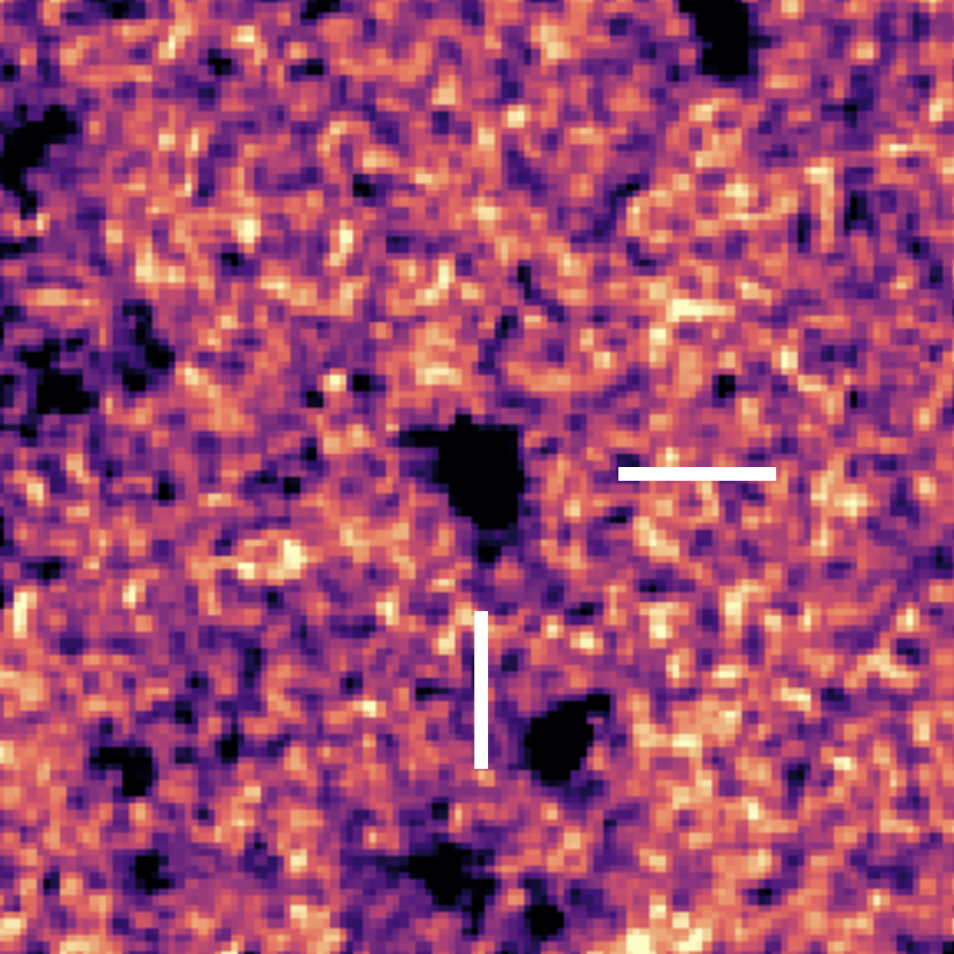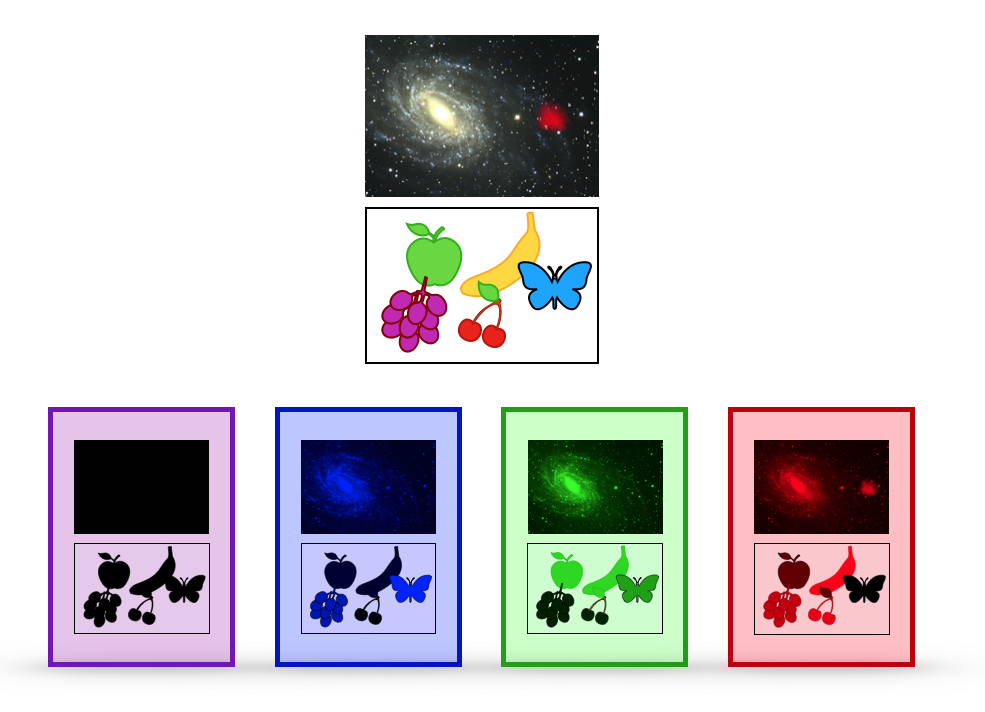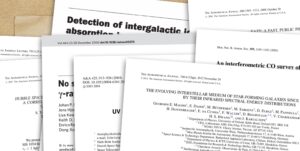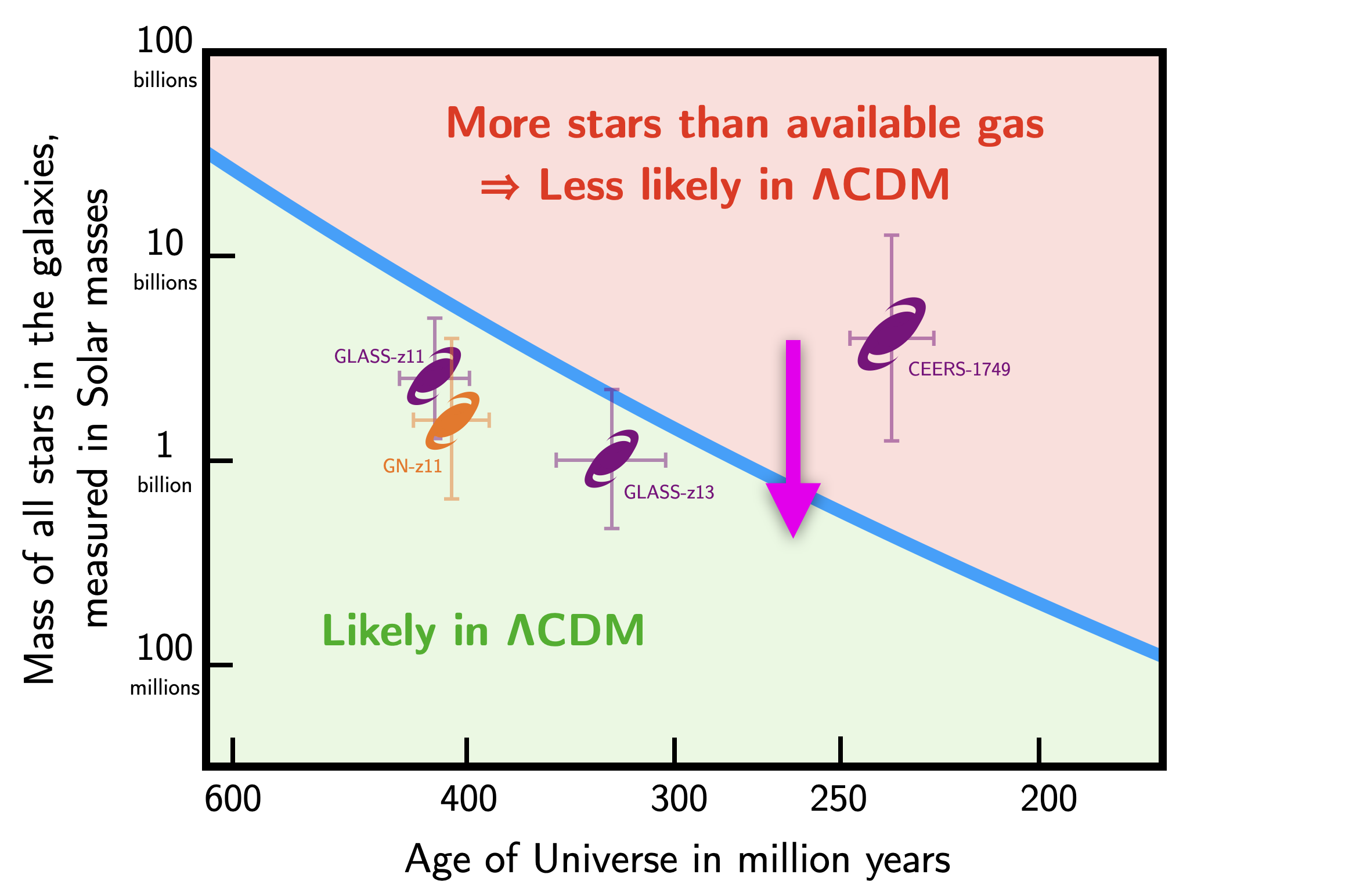Galaxies at Cosmic Dawn
Since the James Webb Space Telescope began releasing its science observations last month, candidates for increasingly distant galaxies have been reported on a regular basis. In fact, the size and the number of distant galaxies seem to challenge our understanding of how galaxies form, although there are many caveats and alternative explanations. Are we facing a cosmological paradigm shift, are we misinterpreting our data, or could there be more mundane reasons? Astronomers at the Cosmic Dawn Center in Copenhagen are working intensely on solving this puzzle.

James Webb in front of the galaxy cluster SMACS 0723, the first field of galaxies to be revealed from the telescope. Credit: NASA, ESA, CSA, STScI.
This is a more in-depth article than our usual news, giving a highly topical insight into how astronomy research is carried out.
For a significantly shorter overview of the exciting results described, you can read the news story James Webb challenges cosmic dawn.
After half a year of cooling, calibrating, and commissioning its instruments, the James Webb Space Telescope is finally ready for science. From July 14, beautiful and fascinating observations of galaxies have been disclosed and ever since, it seems that Webb keeps breaking its record of the most distant galaxy.
Because the most distant galaxy is also the one seen farthest back in time, these observations are not only a matter of breaking a record, but put important constraints on the timescales of structure formation in the Universe. The hitherto most distant galaxy, dubbed "GN-z11", is seen at a time when the Universe was only 400 million years old, but now we see reports of galaxies seen 300 and even 200 million years after the Big Bang.
Observations challenge theories
That's of course fantastic! But it is also slightly worrying. Although we haven't before seen anything at these distances, we have a good theoretical understanding of when the first stars and galaxies should emerge.
Or so we thought.
According to the widely accepted model of the structure and evolution of the Universe — the so-called ΛCDM model (standing for "Lambda cold dark matter") — galaxies should build up in a hierarchical manner:
The first structures to form should be "small" clumps with masses of a million Suns or less. Subsequently these clumps should merge to form first dwarf galaxies and later larger galaxies with billions or trillions of stars which, in turn, merge to form galaxy groups and, finally, the massive galaxy clusters.
Nevertheless, the recent reports seem to claim not only too many, but also too bright and, by proxy, too big galaxies for those epochs.
The galaxies simply shouldn't have had the time to build up that amount of mass.
“Remarkably luminous galaxies”
The first report came less than a week after the data release, when Rohan Naidu, freshly graduated from Harvard and soon-to-be NASA Hubble fellow at MIT, announced the discovery of two remarkably luminous galaxies, the most distant of which is seen 330 million years after the Big Bang.
Two of Naidu's co-authors, Pascal Oesch and Gabriel Brammer, were in fact the discoverers of GN-z11, the current record-holder mentioned above. They are both associate professors at the Cosmic Dawn Center (DAWN) in Copenhagen, a research center dedicated to unraveling the mysteries of the first galaxies.

The galaxy GLASS-z11, as seen through a filter that transmits only infrared light at a wavelength of 3½ micrometer. Darker color means more light. Credit: Rohan Naidu & Pascal Oesch.
"From our current understanding of the timescales of galaxy formation, this is quite puzzling," Gabriel Brammer says. "We wouldn't expect such massive galaxies to show up in these epochs unless we had surveyed an area at least 10 times larger. "
Pascal Oesch elaborates: "The galaxies indicate important constraints on the epoch known as the »Cosmic Dawn«, when the first luminous sources in the Universe emerged. If confirmed, they show that the discovery of GN-z11 was not pure luck, but that evolved galaxies like these were more common in the early Universe than we thought was possible."
While they aren't physically impossible, such massive galaxies at such early times should be so rare that finding one would be extremely unlikely.
"The population of galaxies is in some sense analogous to the population of animals in the sea. There are many plankton, fewer fish, and very few blue whales. Finding a blue whale isn't in itself impossible, but taking a random bucket of water and finding a blue whale is rather remarkable," Gabriel Brammer muses.
Naidu and his team dubbed the two galaxies GLASS-z11 and GLASS-z13, and submitted their work to the scientific journal Astrophysical Journal Letters, but — as is customary in astronomy and other scientific fields — also uploaded it to the preprint server arXiv.org.
Through the looking glass
The origin of the two galaxies' names comes from the observational program behind the images, called GLASS; an acronym for "Grism Lens-Amplified Survey from Space". The word "Lens" refers to the fact the telescope has been intentionally pointed toward a massive cluster of galaxies, the gravitational field of which makes the cluster act like a lens, or looking glass, amplifying the light from distant background galaxies.
The GLASS program has been carefully planned for many years by a "competing" team, but as with most of the data from James Webb — and in astronomy in general — the data are open to anyone who wants to study them (also, competition in the astro-community is mostly quite friendly, and the team even includes researchers from DAWN).
Literally two minutes after Naidu and his team uploaded their results to the arXiv preprint server, the GLASS team uploaded another article. Besides spotting the same two bright galaxies, this study reported on the discovery of five fainter galaxies, seen out to a distance corresponding to 270 million years after the Big Bang.
In the weeks to follow, more reports on distance record-breaking galaxies appeared, suggesting discoveries as far back as 180 million years after the Big Bang.
Cosmic Dawn
The term "cosmic dawn" is moniker used for the epoch in the history of the Universe, shortly after the birth of the first luminous sources — stars and galaxies — began brightening up the Universe.
Cosmic Dawn Center (DAWN) is a basic research center in astronomy, supported by the Danish National Research Foundation. Researching in particular the earliest galaxies, DAWN is a collaboration between the Niels Bohr Institute at the University of Copenhagen, and at the National Space Institute at the Technical University of Denmark (DTU Space).
Galaxy drop-outs
Naturally astronomers, astronomy enthusiasts, and press people alike are thrilled at these discoveries. Nevertheless, there are quite a few important caveats to bear in mind:
Firstly, it must be remembered that none of these reports are peer-reviewed yet. Right now, experts in galaxy formation and early Universe physics are meticulously scrutinizing the articles, looking for possible errors and shortcomings.
Secondly, it is important to realize that, at the moment all these galaxies are only "candidates"; images that seem to imply distant galaxies.
To understand why, we have to go a little technical:
As light travels through the expanding Universe, its wavelength is stretched, or redshifted. The farther away a galaxy is, the redder it looks. The most distant ones are "redder than red", and can only be seen in the infrared.
Fortunately, this is exactly what James Webb can do.
To measure the exact redshift, and hence distance, we need a spectrum; a graph of the light's distribution of wavelengths. But spectra take a long time to obtain, and we need to know where to look.
Instead we can measure an approximate color by taking images with various color filters, in that way getting a rough idea about its distance. This method is called the "drop-out technique", but to confirm the nature of the galaxies, they each need to be followed up spectroscopically.
More on the drop-out technique
(you can skip this if you want)
In astronomy, we have essentially two ways of observing light: We can take an image, like with an ordinary camera, or we can take a spectrum, where the light is dispersed according to its wavelength. While arguably not as beautiful as images, spectra are an invaluable source of information about astronomical objects, revealing their composition, temperature, motion, and much more.
A break in the light
Galaxies emit light across the full electromagnetic spectrum of light. But the short-wavelength UV light tends to be absorbed by gas surrounding the galaxy (you can blame quantum mechanics for that), especially in the early Universe.
This physical process creates a "break" in the spectrum of light. Below a certain wavelength, the intensity drops sharply to zero.
Filtering the light
If we then take a series of images of a nearby galaxy with different color filters, the galaxy will then simply be invisible in the UV filter — we say that the galaxy has "dropped out" of the UV filter. But if we look at distant galaxies, whose light has been stretched to longer and redder wavelengths, they will also drop out of longer-wavelength filters.
The figure below illustrates this effect: A nearby galaxy on the left is visible in the red, green, and blue filter, but invisible in the UV filter. A more distant galaxy on the right is only visible in the red filter. Some everyday objects are shown for illustrative purposes.

Illustration and imaging of the galaxy NGC 6744: Peter Laursen.
The farther away galaxies are, the more their light is redshifted, and hence they will drop out of successively redder filters. The ones reported for the James Webb Space Telescope have even dropped out of the near-infrared filters, and are only visible in the mid-infrared ones, indicating (but not proving) a large distance.
Because an image may contain thousands of galaxies, this technique offers a fast way to get a rough measure of the redshift, and hence the distance of many galaxies in one go.
Dust, death, or distance?
One reason that the drop-out technique is uncertain is that distance is not the only reason an object may be reddened. When stars die, they generate heavy elements which coalesce to form dust. The dust in turn absorbs some of the light, but happens to preferentially absorb the short-wavelength blue and ultraviolet light, letting the longer-wavelength red and infrared light through.
Another possibility is that a galaxy could have stopped forming stars. While some galaxies keep forming new stars all the time, in others continued star formation is, for various reasons, halted, or "quenched". The first stars to burn out happen to be the bluest stars, while the red stars live much longer, giving these "dead" galaxies an orange/reddish hue.
For this reason, some of the galaxies are likely much closer to us, but very dusty and/or have stopped forming stars. This is a well-known source of confusion, and was also pointed out in a succeeding article by Rohan Naidu's team who showed that one of the most distant candidates, dubbed CEERS-1749, allegedly seen when the Universe was 220 million years old, could also be a dusty or a quenched galaxy.
"If CEERS-1749's distance is confirmed, it really does challenge virtually every early galaxy evolution model that assumes a ΛCDM cosmology," Gabriel Brammer explains. "But our analysis shows that it could also be a more nearby galaxy seen when the Universe was more than a billion years old."
Pascal Oesch continues: "That doesn't make it less interesting, though. This would either make CEERS-1749 the earliest quenched galaxies ever seen, or one of the lowest-mass dusty galaxies."
Timeline of the evolution of the Universe, with time running left to right, showing the time at which we see the four galaxies discussed in this review. To emphasize things happening in the early Universe, time is "stretched" close to the Big Bang (far left), and "squeezed" close to today (far right). As we look further and further back in time, we see less and less evolved galaxies. Illustration: Peter Laursen (background image: ESO/NOAJ).
A cosmic coincidence?
Galaxies are not distributed evenly throughout space — rather, they form a "cosmic web" of filaments, separated by enormous voids. Where the filaments meet is where the massive galaxy clusters form.
The current James Webb deep fields span only very small regions on the sky. Although the probability is small, we could in principle have been "lucky" and happened to point James Webb in a few fortunate directions with galaxy overdensities. Finding a blue whale in a bucket of water, so to speak.
If this is the case, then we should soon be enlightened: While some programs aim to look deeply into small regions, other programs will survey much larger regions, although more shallowly.
One such program is COSMOS-Web which will study an area on the sky corresponding to a pea held at an arm's length. For comparison, the regions studied so far are tiny; equivalent to the size of a grain of sand held at an arm's length.
The COSMOS region has already been studied thoroughly with several space- and earth-based telescopes. Georgios Magdis is an associate professor at DAWN and a co-investigator of COSMOS-Web. He is looking forward to beginning the program, but will have to wait a while: Because Webb must always be shielded from the heat of the Sun, at any given time it can only look away from it. At the moment of writing, the COSMOS field happens to be just next to the Sun, but on 25 December — coincidentally the 1-year anniversary of the launch of James Webb — the COSMOS-Web survey will commence.
Nevertheless, it will be worth the wait:
"COSMOS-Web is designed to give us a robust, statistical overview of the properties of early galaxies, observing ten times more galaxies than all other James Webb and Hubble surveys together," Georgios Magdis explains. "Combined with results from other wide-field surveys such as CEERS, in half a year from now we will have a much better understanding of what's going on."
Bursty star formation
Most things in the Universe follow a distribution where there are many of the small, and few of the big. This is true not only for stars and galaxies, but also for cities, lakes, and wealths. For stars and galaxies, these distributions are well studied in the local Universe, but in the very distant Universe we have until now had to rely on extrapolations from the nearby Universe, and our understanding of fundamental physics.
The theoretical foundations of structure formation were laid down around 50 years ago, and has since been improved in particular with the aid of computer models. In a new theoretical extension to the theory, astrophysicist Charlotte Mason, associate professor at DAWN, offers an explanation:
"While we have an idea about the average size and brightness of galaxies, star formation doesn't always follow this average," Mason explains. "In particular in young galaxies, stars occasionally form in intense bursts, for a brief period making the galaxy extremely bright."
Moreover, because dust is made by stars, these earliest starbursts are virtually dust-free. With less dust to absorb the emitted starlight, they appear brighter than what might be inferred from more nearby galaxies.
Taking into account a more random star formation, where stars sometimes form slowly and other times fast, as well as more dust-free environs, Mason's calculations suggest that what we are seeing is "the tip of the iceberg"; extremely highly star-forming galaxies which are unlikely to be representative of the overall galaxy population. If this is true, future and deeper observations with James Webb should reveal a more typical population of galaxies.
Physics isn't (necessarily) broken
Stars are made of gas, but galaxies are surprisingly inefficient at forming stars. If early galaxies were more effective at forming stars than the ones we know from the local Universe, they wouldn't need to be so big in order to look so bright.
However, even if we assume that they were 100% effective, and that all gas in early galaxies were converted to stars — meaning that they would be at least 10 times more efficient than local galaxies — several of the reported galaxies seem to defy physics.
The figure below places the galaxies discussed above — the current record-holder GN-z11, and its challengers GLASS-z11, GLASS-z13, and CEERS-1749 — in a diagram that shows both the mass of their stars (with values on the left axis), and the age of the Universe where we see them (with values on the bottom axis). The blue line divides the diagram between what is likely, and what is unlikely within our current model of the Universe, the ΛCDM model.
Illustration of the reported galaxies' mass and the age of the Universe. The farther up a galaxy is shown, the more stars it contains, and the farther to the right, the younger we see it (the crosses illustrate our uncertainty in the actual position). Within our widely accepted understanding of the Universe — the so-called ΛCDM model — galaxies are not "supposed" to lie in the red region of the diagram, because they have grown too big in too little time. Credit: Rohan Naidu, Pascal Oesch & Peter Laursen.
The galaxies all lie close to or even inside "the forbidden region". And here we even assumed that they're 100% effective at forming stars; if we instead assumed a more typical effectivity, they would all lie above the blue line. Other recently reported galaxies would similar lie above the limit.
So, are the detections false? Are the galaxies distant, or are they dead or dusty? Have we been looking in a lucky direction? Has ΛCDM been broken?
In one of the most recent papers on arXiv, Charles Steinhardt, associate professor at DAWN, and his collaborators propose yet another explanation.
"Despite its success, the ΛCDM model is, after all, only a model expressing our ignorance of, in particular, dark energy and dark matter. There are various ways to ‘fix’ ΛCDM, most of which include tuning the assumed properties of dark matter," Charles Steinhardt describes. "You might even argue that ΛCDM isn't a ‘real’ model, but only a ‘placeholder’ for a model."
Ethan Garcia, a visiting summer student at DAWN from Caltech, California, and a co-author of the article, explains: "The models that we use to calculate the properties of galaxies, including their distance, are built upon our knowledge of much more nearby galaxies. We know that the physical conditions in the early Universe were significantly different from today, and changing the conditions in our calculations makes an enormous difference in the properties we calculate."
One of the things that was different is that the Universe and its gas was hotter in the past. This affects the mass of the stars that are formed. Albert Sneppen, a master student at DAWN and co-author of the paper, recently showed what happens if this effect is taken into consideration.
"If we account for the different gas temperature in the early Universe, the calculated masses of the galaxies seems to be significantly smaller, probably at least ten times," explains Albert Sneppen.
If the galaxies are ten times less massive, that would mean that, in the diagram above, they should instead be moved down by an amount indicated by the magenta arrow, pushing them into the more likely (green) region and saving ΛCDM.
Are we any wiser now?
So what is the conclusion? Mostly "Hold your horses!", it seems. While we are definitely currently witnessing an explosion of new insight into the physics of galaxies, there are many circumstances to consider before boldly declaring that we are entering a new paradigm.
In the astro-community, there's a joke that many articles somewhat fuzzily conclude by claiming that "More data are needed". But that is indeed the case for James Webb. Fortunately, more data will soon arrive, and researchers at the Cosmic Dawn Center and around the world will continue their investigations over the months and years to come.
More information
Contact
- Peter Laursen (Danish; English)
- Pascal Oesch (Swiss; English)
- Gabe Brammer (English)
- Charlotte Mason (English)
- Georgios Magdis (Greek; English)
- Charles Steinhardt (English)
- Ethan Garcia (English)
- Albert Sneppen (Danish; English)
Scientific articles
The studies described in this and the background article have all been submitted to various scientific journals. Preprints are available at the arXiv preprint server:
- Naidu, Oesch, et al. (2022a), Two Remarkably Luminous Galaxy Candidates at z≈11−13 Revealed by JWST, submitted to ApJL.
- Castellano et al. (2022), Early results from GLASS-JWST. III: Galaxy candidates at z∼9-15, submitted to ApJL.
- Naidu, Oesch, et al. (2022b), Schrodinger's Galaxy Candidate: Puzzlingly Luminous at z≈17, or Dusty/Quenched at z≈5?, submitted to ApJL.
- Mason et al. (2022), The brightest galaxies at Cosmic Dawn, submitted to MNRAS.
- Steinhardt et al. (2022), Templates for Fitting Photometry of Ultra-High-Redshift Galaxies, submitted to ApJ.
See also
- Kartaltepe, Casey, et al., COSMOS-Web: The JWST Cosmic Origins Survey, JWST GO 1727.
- Sneppen et al. (2022), Implications of a Temperature Dependent IMF I: Photometric Template Fitting, published in ApJ.
Danish version
To read this news story in Danish, click here.
Tags: DAWN papers, JWST



